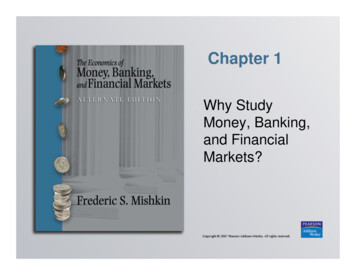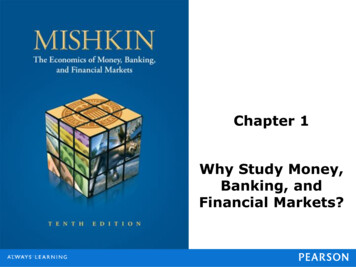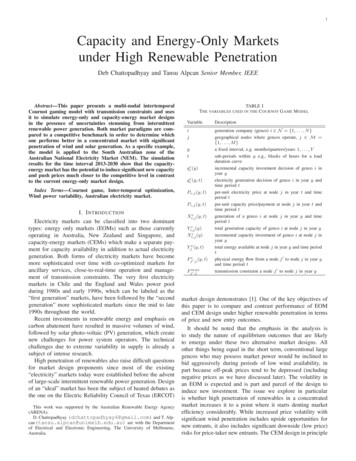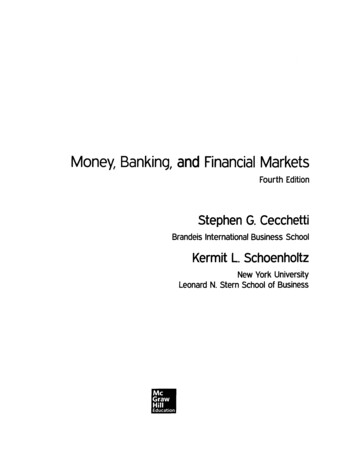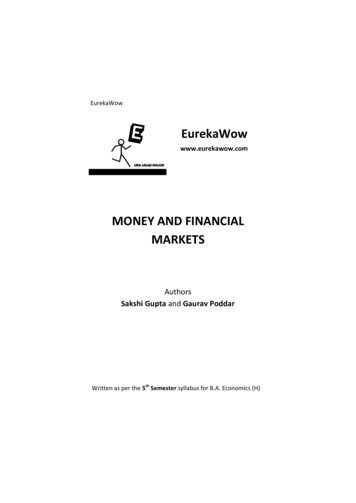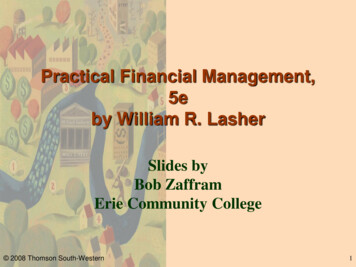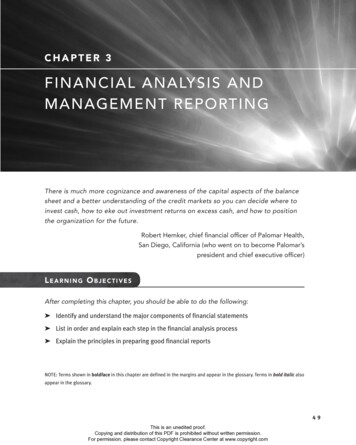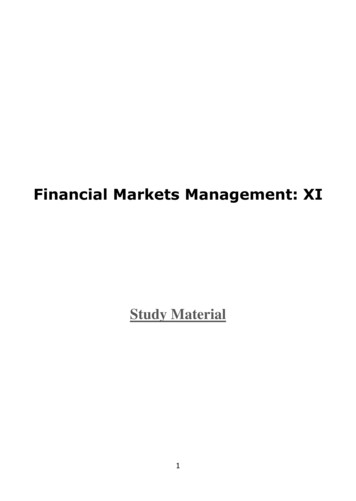
Transcription
Financial Markets Management: XIStudy Material1
PrefaceNSE and CBSE Certification in Financial Markets (NCFM)NCFM is an online certification programme aimed at upgrading skills and building competency.The programme has a widespread reach with testing centres present at more than 154 locationsacross the country.The NCFM offers certifications ranging from the Basic to Advanced.One can register for the NCFM through: Online mode by creating an online login id through the link ‗Education‘ ‗Certifications‘ ‗OnlineRegister / Enroll‘ available on the website www.nseindia.com Offline mode by filling up registration form available on the website www.nseindia.com ‗Education‘ ‘Certifications‘ ‗Register for Certification‘Once registered, a candidate is allotted a unique NCFM registration number along with an onlinelogin id and can avail of facilities like SMS alerts, online payment, checking of test schedules, onlineenrolment, profile update etc. through their login id.2
ContentsFINANCIAL MARKET MANAGEMENT – XICHAPTER 1: Markets and Financial Instruments.91.1What is Investment? . 91.2What are various options available for investment? . 101.3What is meant by a Stock Exchange? . 121.4What is a Depository? . 131.5What is meant by ‗Securities‘? . 141.6Regulator . 151.7Participants . 16Points to Remember .17CHAPTER 2: Primary and Secondary Market.182.1What is the role of the ‗Primary Market‘? . 182.2Issue of Shares . 182.3What is meant by Issue price? . 192.4What is an Initial Public Offer (IPO)? . 202.5What is a Prospectus? . 222.6What is meant by ‗Listing of Securities‘? . 232.7What is SEBI‘s Role in an Issue? . 232.8Foreign Capital Issuance . 242.9Introduction . 252.10 Stock Exchange . 252.11 Depository 262.11.1 How is a depository similar to a bank?.262.11.2 Which are the depositories in India?.262.12 Stock Trading . 282.13 What precautions must one take before investing in the stock markets? . 312.14 Products in the Secondary Markets . 332.15 Equity Investment . 342.16 Debt Investment . 362.17 Miscellaneous .382.17.1 Corporate Actions .382.17.2 Index .402.17.3 Clearing & Settlement and Redressal .402.17.4 What is a Book-closure/Record date?.412.17.5 What recourses are available to investor/client for redressing hisgrievances?.423
2.17.6 What is Arbitration?.422.17.7 What is an Investor Protection Fund?.422.17.8 What is SEBI SCORES?.42Points to Remember .43CHAPTER 3: Financial Statement Analysis.443.1CONCEPTS & MODES OF ANALYSIS 443.1.1What is Simple Interest? . 443.1.2 What is Compound Interest?. 443.1.3 What is meant by the Time Value of Money? . 463.1.4 How to go about systematically analyzing a company? . 493.2RATIO Analysis. 583.2.1 Liquidity ratios: . 583.2.2 Leverage/Capital structure Ratios: . 603.2.3 Profitability ratios: . 613.2.4 Illustration: . 62Points to Remember . .64CHAPTER 4: Mutual Funds Products and Features.654.1Introduction: . .654.2Mutual Funds: Structure In India.674.3Who Manages Investor‘s Money?.684.4Who is a Custodian?. .694.5What is the Role of the AMC?.694.6What is an NFO?.704.7What is the role of a registrar and transfer agents?.704.8What is the procedure for investing in an NFO?.704.9What are the investor‘s rights & obligations?.714.10 What are the different schemes offered by Mutual Funds? . 724.11 Category wise funds . 734.12 What are open ended and close ended funds? . 734.13 What are Equity Oriented Funds? . 744.13.1 Introduction . 744.144.13.2 Equity Fund Definition . 74What is an Index Fund?.754.15What are diversified large cap funds? .764.16What are midcap funds?.774.17What are Sectoral Funds?.774.18Other Equity Schemes :.774.18.1 Arbitrage Funds .774
4.18.2 Multicap Funds .774.18.3 Quant Funds .774.18.4 International Equities Fund .784.18.5 Growth Schemes.784.18.6 ELSS .794.18.7 Fund of Funds .794.19What is the importance of basic offer documents (SID and SAI)? . 804.20What is the key information document . 804.21What is NAV? . 814.22What are expenses incurred in relation to a scheme . 834.23What is Expense Ratio? . 844.24What is Portfolio Turnover?. 844.25How does AUM affect portfolio turnover? . 854.26How to analyse cash level in portfolios? . 864.27What are exit loads? . 86Points to Remember .86CHAPTER 5: ETFs, Debt and Liquid Funds.895.1Introduction to Exchange Traded Funds . 895.2Salient Features . 895.3What are REITS . 915.4Why Gold ETF . 915.5Working . 923.5.1 During New Fund Offer (NFO) . 923.5.2 On an ongoing basis . 925.6Sovereign Gold Bonds . 935.6.1Product Details of Sovereign Gold Bonds . 935.7Market Making by APS . 965.8Creation units, Port Folio deposit and cash component . 96(an example)5.9Salient Features . 985.10What is Interest Rate Risk? . 995.11What is Credit Risk? .1005.12How is a Debt Instrument Priced? .1015.13Debt Mutual Fund Schemes .1055.13.1Fixed Maturity Plans .1055
5.13.2 Capital Protection Funds .1055.13.3 Gilt Funds .1055.13.4 Balanced Funds .1055.13.5 MIPs .1055.13.6 Child Benefit Plans .1065.14Salient features .1065.15Valuation of securities.1075.16Floating rate scheme .1085.17What is portfolio churning in liquid funds? .1085.18Stress testing of assets .108Points to Remember .109CHAPTER 6: Taxation and Regulation.1116.1Capital gains taxation .1116.2Indexation benefit .1126.3Dividend distribution tax .1126.4Why FMPS are popular? .1136.5Overview .1136.6What is the name of industry association for the Mutual Fund Industry? .1146.7What are the objectives of AMFI? .1146.8Product labelling in mutual funds – riskometer .1156.9Advantages of Mutual Funds .1156.10What is a Systematic Investment Plan (SIP)? .1166.11What is Systematic Transfer Plan (STP)? .1176.12What is Systematic Withdrawal Plan (SWP)? .1186.13Choosing between dividend payout, dividend reinvestment and growth options –which one is better for the investor? .1186.13.1 Growth option .1186.13.2 Dividend payout option .1186.13.3 Dividend reinvestment option .119Points to Remember .1206
UNIT-1 Markets and Financial Instruments1.1WHAT IS INVESTMENT?The money you earn is partly spent and the rest saved for meeting future expenses. Instead ofkeeping the savings idle you may like to use savings in order to get returns on it in the future. Thisis called Investment.1.1.1Why should one invest?One needs to invest to: earn return on your idle resources generate a specified sum of money for a specific goal in life make a provision for an uncertain futureOne of the important reasons why one needs to invest wisely is to meet the cost of Inflation.Inflation is the rate at which the cost of living increases. The cost of living is simply what it costs tobuy the goods and services you need to live. Inflation causes money to lose value because it willnot buy the same amount of a good or a service in the future as it does now or did in the past. Forexample, if there was a 6% inflation rate for the next 20 years, a Rs. 100 purchase today wouldcost Rs. 321 in 20 years. This is why it is important to consider inflation as a factor in any longterm investment strategy. Remember to look at an investment‘s ‗real‘ rate of return, which is thereturn after inflation. The aim of investments should be to provide a return above the inflation rateto ensure that the investment does not decrease in value. For example, if the annual inflation rateis 6%, then the investment will need to earn more than 6% to ensure it increases in value. If theafter-tax return on your investment is less than the inflation rate, then your assets have actuallydecreased in value; that is, they won‘t buy as much today as they did last year.1.1.2When to start Investing?The sooner one starts investing the better. By investing early you allow your investments moretime to grow, whereby the concept of compounding (as we shall see later) increases your income,by accumulating the principal and the interest or dividend earned on it, year after year. The threegolden rules for all investors are: Invest early Invest regularly Invest for long term and not short termWarren Buffet Quote: ―I bought my first share at the age of 11 years and even then itwas too late!‖11.1.3What care should one take while investing?Before making any investment, there are certain steps to ensure safety of investments. There are12 important steps to investing where the investor must make sure to:1.Obtain written documents explaining the investment2.Read and understand such documents3.Verify the legitimacy of the investment4.Find out the costs and benefits associated with the investment5.Assess the risk-return profile of the investment7
6.Know the liquidity and safety aspects of the investment7.Ascertain if it is appropriate for your specific goals8.Compare these details with other investment opportunities available9.Examine if it fits in with other investments you are considering or you have already made10. Deal only through an authorised intermediary11. Seek all clarifications about the intermediary and the investment and invest only if you arecomfortable. Refuse to invest if you are not convinced.12. Explore the options available to you if something were to go wrong, and then, if satisfied,make the investment.1.1.4What is meant by Interest?When we borrow money, we are expected to pay for using it - this is known as Interest. Interest isan amount charged to the borrower for the privilege of using the lender‘s money. Interest isusually calculated as a percentage of the principal balance (the amount of money borrowed). Thepercentage rate may be fixed for the life of the loan, or it may be variable, depending on the termsof the loan.1.1.5What factors determine interest rates?When we talk of interest rates, there are different types of interest rates - rates that banks offer totheir depositors, rates that they lend to their borrowers, the rate at which the Government borrowsin the Bond/Government Securities market, rates offered to investors in small savings schemes likeNSC, PPF, rates at which companies issue fixed deposits etc.The factors which govern these interest rates are mostly economy related and are commonlyreferred to as macroeconomic factors. Some of these factors are: Demand for money Level of Government borrowings Supply of money Inflation rateThe policies set by the Reserve Bank of India and the Government determine some of the variablesmentioned above.1.2WHAT ARE VARIOUS OPTIONS AVAILABLE FOR INVESTMENT?One may invest in: Physical assets like real estate, gold/jewellery, commodities etc. and/or Financial assets such as fixed deposits with banks, small saving instruments with postoffices, insurance/provident/pension fund etc. or securities market related instruments like shares,bonds, debentures, mutual funds, etc.Investment OptionsShort-term investment Savings bank account Money market funds Public Provident Fund Bank fixed deposits Company fixed deposits1.2.1 Post Office savings Long –term investmentBonds and debenturesMutual Funds Life Insurance Policies Equity sharesWhat are various Short-term financial options available for investment?8
Broadly speaking, savings bank account, money market/liquid funds and fixed deposits with banksmay be considered as short-term financial investment options. Savings Bank Account is often the first banking product people use, which offers low interest(4%-6% p.a.), making them only marginally better than fixed deposits. Money Market or Liquid Funds are a specialized form of mutual funds that invest inextremely short-term fixed income instruments and thereby provide easy liquidity. Unlike mostmutual funds, money market funds are primarily oriented towards protecting your capital andthen, aim to maximise returns. Money market funds usually yield better returns than savingsaccounts, but lower than bank fixed deposits. Fixed Deposits with Banks are also referred to as term deposits and minimum investmentperiod for bank FDs is 30 days. Fixed Deposits with banks are for investors with low riskappetite, and may be considered for 6-12 months investment period as normally interest onless than 6 months bank FDs is likely to be lower than money market fund returns.1.2.2What are various Long-term financial options available for investment?There are several options available for long term investments like Post Office Savings Schemes,Public Provident Fund, Company Fixed Deposits, Bonds and Debentures, Mutual Funds etc. Post Office Savings: Post Office Monthly Income Scheme is a low risk saving instrument,which can be availed through any post office. It provides an interest rate of 8.4% per annum,which is paid monthly. Minimum amount, which can be invested, is Rs. 1,000/- and additionalinvestment in multiples of 1,500/-. Maximum amount is Rs. 4,50,000/- (if Single) or Rs.9,00,000/- (if held Jointly) during a year. It has a maturity period of 6 years. A bonus of 10%is paid at the time of maturity. Premature withdrawal is permitted if deposit is more than oneyear old. A deduction of 5% is levied from the principal amount if withdrawn prematurely; the10% bonus is also denied. Public Provident Fund: A long term savings instrument with a maturity of 15 years andinterest payable at 8.7% per annum compounded annually. A PPF account can be openedthrough a nationalized bank at any time during the year and is open all through the year fordepositing money. Tax benefits can be availed for the amount invested and interest accrued istax-free. A withdrawal is permissible every year from the seventh financial year of the date ofopening of the account and the amount of withdrawal will be limited to 50% of the balance atcredit at the end of the 4th year immediately preceding the year in which the amount iswithdrawn or at the end of the preceding year whichever is lower the amount of loan if any. Company Fixed Deposits: These are short-term (six months) to medium-term (three to fiveyears) borrowings by companies at a fixed rate of interest which is payable monthly,quarterly, semi-annually or annually. They can also be cumulative fixed deposits where theentire principal along with the interest is paid at the end of the loan period. The rate ofinterest varies between 8-12% per annum for company FDs. The interest received is afterdeduction of taxes. Bonds and Debentures: It is a fixed income (debt) instrument issued for a period of morethan one year with the purpose of raising capital. The central or state government,corporations and similar institutions sell bonds. A bond is generally a promise to repay theprincipal along with a fixed rate of interest on a specified date, called the Maturity Date.Debentures are instruments issued by companies similar to bonds. These could beconvertible, non-convertible or partly convertible. Convertible debentures can be fullyconverted to equity at the option of the debenture holder on maturity. Non-convertibledebentures are fully repaid on maturity and partly convertible debentures are partly repaidand partly convertible on maturity, at the option of the debenture holder. Mutual Funds: These are funds operated by an investment company which raises money fromthe public and invests in a group of assets (shares, debentures etc.), in accordance with a9
stated set of objectives. It is a substitute for those who are unable to invest directly in equitiesor debt because of resource, time or knowledge constraints. Benefits include professionalmoney management, buying in small amounts and diversification. Mutual fund units are issuedand redeemed by the Fund Management Company based on the fund‘s net asset value (NAV),which is determined at the end of each trading session. NAV is calculated as the value of allthe shares held by the fund, minus expenses, divided by the number of units issued. MutualFunds are usually long term investment vehicles though there some categories of mutualfunds, such as money market mutual funds which are short term instruments. Life Insurance Policies: Though not strictly investment avenues, life insurance policies alsocan be considered so based on the type of policy. Life Insurance is a contract providing forpayment of a sum of money to the person assured or, following him to the person entitled toreceive the same, on the happening of a certain event. It is a good method to protect yourfamily financially, in case of death, by providing funds for the loss of income. Types of policiesinclude term life insurance, endowment policies, annuities/pension policies and Unit LinkedInsurance Plans or ULIPs. In term life policies, lump sum is paid to designated beneficiary incase of the death of the insured. Endowment policies provide for periodic payment ofpremiums and a lump sum amount either in the event of death of the insured or on the date ofexpiry of the policy, whichever occurs earlier. Annuities/pension policies give a guaranteedincome for life or for a certain period. In case of the death, or after the fixed annuity periodexpires for annuity payments, the invested annuity fund is refunded, usually with someadditional amounts as per the terms of the policy. A ULIP is a life insurance policy whichprovides a combination of risk cover and investment.1.3WHAT IS MEANT BY A STOCK EXCHANGE?The Securities Contract (Regulation) Act, 1956 [SCRA] defines ‗Stock Exchange‘ as any body ofindividuals, whether incorporated or not, constituted for the purpose of assisting, regulating orcontrolling the business of buying, selling or dealing in securities. Stock exchange could be aregional stock exchange whose area of operation/jurisdiction is specified at the time of itsrecognition or national exchanges, which are permitted to have nationwide trading since inception.NSE was incorporated as a national stock exchange.1.3.1What is an ‘Equity’/Share?Total equity capital of a company is divided into equal units of small denominations, each called ashare. For example, in a company the total equity capital of Rs 200,00,000 is divided into20,00,000 units of Rs 10 each. Each such unit of Rs 10 is called a Share. Thus, the company thenis said to have 20,00,000 equity shares of Rs. 10 each. The holders of such shares aremembers/owners of the company to the extent of shareholding and have voting rights.1.3.2What is a ‘Debt Instrument’?Debt instrument represents a contract whereby one party lends money to another on predetermined terms with regards to rate and periodicity of interest, repayment of principal amountby the borrower to the lender.In the Indian securities markets, the term “bond” is used for debt instruments issued by theCentral and State governments and public sector organizations and the term ―debenture” is usedfor instruments issued by private corporate sector.1.3.3What is a Derivative?Derivative is a product whose value is derived from the value of one or more basic variables, calledunderlying. The underlying asset can be equity, index, foreign exchange (forex), commodity or anyother asset.10
Derivative products initially emerged as hedging devices against fluctuations in commodity pricesand commodity-linked derivatives remained the sole form of such products for almost threehundred years. The financial derivatives came into spotlight in post-1970 period due to growinginstability in the financial markets. However, since their emergence, these products have becomevery popular and by 1990s, they accounted for about two-thirds of total transactions in derivativeproducts.1.3.4What is a Mutual Fund?A Mutual Fund is a body corporate registered with SEBI (Securities Exchange Board of India) thatpools money from individuals/corporate investors and invests the same in a variety of differentfinancial instruments or securities such as equity shares, Government securities, Bonds,debentures etc. Mutual funds can thus be considered as financial intermediaries in the investmentbusiness that collect funds from the public and invest on behalf of the investors. Mutual funds issueunits to the investors. The appreciation of the portfolio or securities in which the mutual fund hasinvested the money leads to an appreciation in the value of the units held by investors. Theinvestment objectives outlined by a Mutual Fund in its prospectus are binding on the Mutual Fundscheme. The investment objectives specify the class of securities a Mutual Fund can invest in.Mutual Funds invest in various asset classes like equity, bonds, debentures, commercial paper andgovernment securities. The schemes offered by mutualfunds vary from fund to fund. Some are pure equity schemes; others are a mix of equity andbonds. Investors are also given the option of getting dividends, which are declared periodically bythe mutual fund, or to participate only in the capital appreciation of the scheme.1.3.5What is an Index?An Index shows how a specified portfolio of share prices are moving in order to give an indicationof market trends. It is a basket of securities and the average price movement of the basket ofsecurities indicates the index movement, whether upwards or downwards. The main index of theNSE is the Nifty 50. The Nifty 50 is a well diversified 51 stock index accounting for 13 sectors of theeconomy. It is used for a variety of purposes such as benchmarking fund portfolios, index basedderivatives and index funds.1.4WHAT IS A DEPOSITORY?A depository is like a bank wherein the deposits are securities (viz. shares, debentures, bonds,Government securities, units etc.) in electronic form.1.4.1What is Dematerialization?Dematerialization is the process by which physical certificates of an investor are converted to anequivalent number of securities in electronic form and credited to the investor‘s account with hisDepository Participant (DP).11
The above is the image of a physical share certificate. When this is dematerialised, it will beconverted to electronic form. The physical certificate will be destroyed and the number of sharesheld will be transferred to the beneficiary account. The report of the DP submitted to the investorwill look like the image b
Financial Markets Management: XI Study Material . 2 Preface NSE and CBSE Certification in Financial Markets (NCFM) NCFM is an online certification programme aimed at upgrading skills and building competency. The programme has a widespread reach


